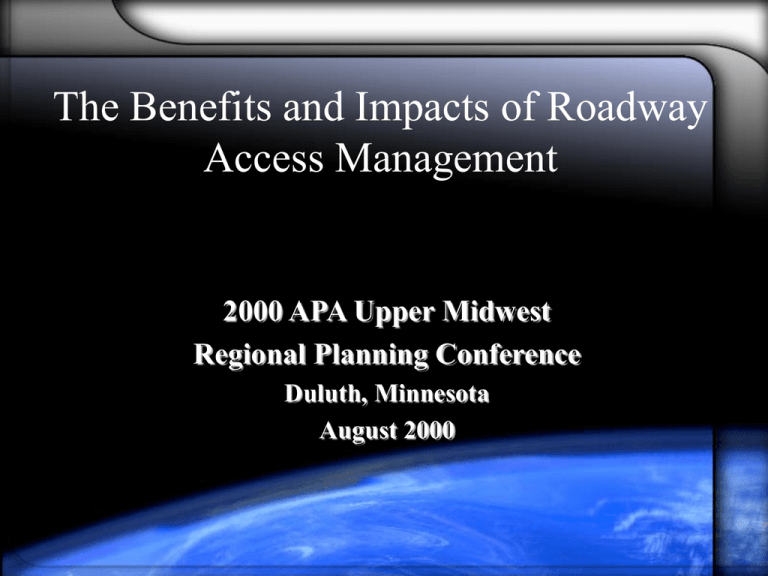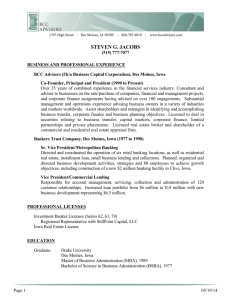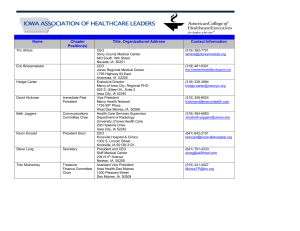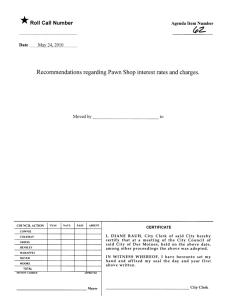Access Management 101 - Center for Transportation Research and
advertisement

The Benefits and Impacts of Roadway Access Management 2000 APA Upper Midwest Regional Planning Conference Duluth, Minnesota August 2000 Presentation Outline • What is access management? – An example corridor • What are the benefits of managing access? • What are the main techniques and treatments for managing access? • How does access management effect business vitality and commercial development? • How can access management be implemented? • Conclusions What Is Access Management? • “Access Management is the process that provides access to land development while simultaneously preserving the flow of traffic on the surrounding road system in terms of safety, capacity, and speed”. (Source: Federal Highway Administration) A Key Goal of Access Management • Maintain the functional integrity of the roadway system Functional Integrity • Reserve high speed, high capacity roads for high speed, long-distance travel • Maintain a “hierarchy” of roads • Balance traffic movement and access to adjacent land by providing land access compatible with the roadway classification Functional Integrity Freeway Arterial Through Traffic Movement Collector Local Access to Property Presentation Outline • What is access management? – An example corridor • What are the benefits of managing access? • What are the main techniques and treatments for managing access? • How does access management effect business vitality and commercial development? • How can access management be implemented? • Conclusions Crashes Are Concentrated Along Arterial Corridors Crash Density Varies Greatly Why? Variations In Access Douglas Avenue: Well-Managed Portion Urbandale, Iowa Douglas Avenue: Moderately Well-Managed Portion Urbandale, Iowa Douglas Avenue: Poorly Managed Portion Des Moines, Iowa Douglas Avenue: Poorly Managed Portion Des Moines, Iowa Douglas Avenue: Poorly Managed Portion Des Moines, Iowa Presentation Outline • What is access management? – An example corridor • What are the benefits of managing access? • What are the main techniques and treatments for managing access? • How does access management effect business vitality and commercial development? • How can access management be implemented? • Conclusions What Are the Main Benefits of Managing Access? • Improved safety – Reduction in crashes and crash rates • Better traffic operations – Improved traffic LOS, capacity, and speed • Other public benefits – For pedestrians, bicyclists, public transit riders, taxpayers, and the environment • Potentially, a better environment in which to do business and pursue economic development Safety: Driveway Density And Crash Rates Are Strongly Related Safety: Crash Rates Are Significantly Lower On Better Managed Roads Safety: Crash Rates Are Significantly Lower On Better Managed Roads • Based on seven detailed “before and after” Iowa case studies • Case studies show nearly a 40 percent average reduction in accident rates after access management projects were completed. 7 Before 6 After 5 4 3 2 1 0 Accident Rate (per MVMT) Safety: Certain Types of Crashes Are Reduced Significantly When Access Is Managed Better Total Other Right Angle Left/Broadside Rear End 0 50 100 150 200 250 Before After Operations: Capacity Is Higher On Better Managed Roads Operations: Travel Speeds Are Higher On Well-Managed Roads Presentation Outline • What is access management? – An example corridor • What are the benefits of managing access? • What are the main techniques and treatments for managing access? • How does access management effect business vitality and commercial development? • How can access management be implemented? • Conclusions How Access Is Managed • The functional integrity of the roadway system can be maintained by: – Limiting conflict points – Separating conflict points – Removing turning traffic from through traffic lanes Conflict Points at an Intersection Limiting Conflict Points: Medians Separating Conflict Points: Why? • Drivers can only mentally process one conflict point at a time • Separation provides enough time and space for drivers to react to the unexpected • Conflict points represent opportunities for accidents, congestion, and delay Separating Conflict Points: Corner Clearance and Driveway Spacing Standards Facilitating Turning Movements: Important Strategies and Design Features • Increased turning radii • Increased driveway width – (while still maintaining well-defined driveways) • • • • Decreased driveway slope Including dedicated turn lanes or tapers Improved sight distance for turning traffic Improved internal site design Facilitating Turning Movements Steeper Driveways = Slower Turns = More Conflict Common Access Management Treatments • • • • • • Driveway consolidation Corner clearance Raised medians Raised medians at intersections Two-way left-turn lanes (TWLTL) Alternative access-ways – Frontage roads – Backage roads – Internal circulation systems New Development With Excellent Internal Circulation Design New Home Depot and Super Target Stores, Delaware Avenue, Ankeny Iowa Presentation Outline • What is access management? – An example corridor • What are the benefits of managing access? • What are the main techniques and treatments for managing access? • How does access management effect business vitality and commercial development? • How can access management be implemented? • Conclusions Access Management and Business Vitality • Business owners often oppose access changes or restrictions (sometimes very aggressively) • Overall impacts on businesses are neutral to positive when access is managed retroactively • Iowa case study results show: – Similar business failure rates – Improved retail sales levels versus other locations in the community – Improved potential for redevelopment/new development – Some individual businesses will be negatively impacted Five Year Comparative Business Survival Rates 70 60 50 40 Community Corridor 30 20 10 0 Ames Ankeny Clive Fairfield Spencer Statewide Note: Based on a five year period bracketing project completion. For corridors, business name changes or moves are counted as failures. First round projects only. Case Study Corridor Sales Tax Revenue Growth Retail Trade Growth Trends, 1990s Average, Without Clive Average Case Studies West Des Moines Des Moines Coralville Bettendorf Spencer Fairfield Clive Ankeny Ames 0 50 100 150 200 250 300 350 Index, 1990=100 Corridor Index Community Index 400 450 500 Same Businesses Sales After Project Completion Reported Sales Trend Post-Project 29% 6% 45% 20% Decrease Same Increase Uncertain/No response Source: Opinion survey of business owners and managers. Businesses Reporting A Loss Of Sales After Project Completion • Nine of 162 businesses surveyed (6%) reported sales losses; these were: – – – – – – – Two gasoline stations (both Des Moines--Median) Two real estate offices (Ankeny--Median and Coralville--TWLTL) A convenience store (Bettendorf--TWLTL) A supermarket (Ankeny--Median) A tanning salon (Clive--Median) A music store (Coralville--TWLTL) A fast food restaurant (Coralville--TWLTL) • Five of these were “auto-oriented” businesses • Five of these involved medians while four involved twoway left-turn lanes Businesses Reporting Any Customer Complaints About Highway Access After Project Completion Businesses Reporting Customer Complaints 28% 72% Complaints reported No complaints Businesses Reporting Customer Access Complaints, By Type Customer Access Complaints By Business Type 28% 43% Restaurant/fast food Auto service/sales/gas station Hotel/motel Insurance/real estate Other business type 19% 6% 4% Well-Managed Corridors May Prove More Attractive To Developers (Two Adjacent Corridors in Des Moines, Iowa) SE 14th Street Army Post Road Presentation Outline • What is access management? – An example corridor • What are the benefits of managing access? • What are the main techniques and treatments for managing access? • How does access management effect business vitality and commercial development? • How can access management be implemented? • Conclusions Implementing Access Management • In most states, roadway jurisdictions are legally responsible for managing access and providing access to properties • State legislation usually spells out the regulatory powers of roadway jurisdictions • Road agencies manage access through access rights purchases, project design, and driveway permitting • Local governments also manage access via land use regulations, particularly when zoning is changed or land is subdivided Implementing Access Management • Involvement of and cooperation among many parties is essential if access is to be managed successfully: – – – – – Road jurisdictions Transportation planning agencies Land use planning and regulatory organizations Business owners Land developers Presentation Outline • What is access management? – An example corridor • What are the benefits of managing access? • What are the main techniques and treatments for managing access? • How does access management effect business vitality and commercial development? • How can access management be implemented? • Conclusions Who Wins When Access Management Is Done Right? • Motorists: safer, less congested roads • Taxpayers: less expensive roads • Most business persons and their customers: improved business and commercial environment • Communities as a whole: environmental and other benefits Contact: David J. Plazak Center for Transportation Research and Education, ISU Research Park, Ames, IA 50010-8615 Telephone: Fax: E-mail: URL: (515) 294-8103 (515) 294-0467 dplazak@iastate.edu http://www.ctre.iastate.edu/access Research Sponsor:




